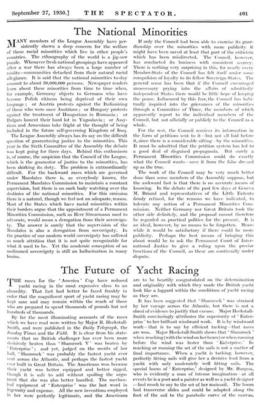The Future of Yacht Racing
THE races for the America ' Cup have reduced
yacht racing in the most expensive class to an absurdity. That fact had better be faced frankly in order that the magnificent sport of yacht racing may be kept sane and may remain within the reach of those who are prepared to spend thousands of pounds but not hundreds of thousands.
By far the most illuminating accounts of the races which we have read were written by Major B. Heckstall- Smith, and were published in the Daily Telegraph, the Sunday Times and the Field. It is clear from his state- ments that no British challenger has ever been more decisively beaten than ' Shamrock V ' was beaten by Enterprise ' ; and yet, judged on the merits of her hull, Shamrock ' was probably the fastest yacht ever sent across' the Atlantic, and perhaps the fastest yacht ever built in Great Britain. The Americans won because their yacht was better equipped and better rigged, though it is safe to add without spoiling the argu- ment that she was also better handled. The mechan- ical equipment of ' Enterprise ' was the last word in ingenuity.and expense. All the new inventions employed in her were perfectly legitimate, and the Americans
are to be heartily congratulated on the determination and originality with which they made the British yacht look like a laggard within the conditions of yacht racing as they are.
It has been suggested that ' Shamrock ' was strained by her voyage across the Atlantic, but there is not a shred of evidence to justify that excuse. Major Heekstall- Smith convincingly attributes the superiority of ' Enter- prise ' to her brilliant windward work. It is by windward work—that is to say by efficient tacking—that races are won. Major Heckstall-Smith shows that ' Shamrock' when reaching (with the wind on her beam) or when running before the wind was faster than ' Enterprise.' In reaching or running the set of the sails is not a matter of final importance. When a yacht is tacking, however, perfectly fitting sails will give her a decisive lead from a yacht with only moderately well fitting sails. The special boom of ' Enterprise,' designed by Mr. Burgess, who is evidently a man of intense imagination—at all events he is a poet and a painter as well as a yacht designer —had much to say to the set of her mainsail. The boom had transverse slides and could be adapted along the foot of the sail to the parabolic curve of the canvas. Then there was the duralumin mast which Major Heck- stall-Smith calculates saved Enterprise' a ton and a- half of weight. The centre of gravity of the dead weight of the mast in yachts of the type of `Shamrock' and Enterprise' is sixty or seventy feet above the water. It is easy to see, therefore, how much adverse leverage at that point Enterprise' was saved as compared with ` Shamrock.' Yet again, although Enterprise's ' sheets, runners, and so forth, were handled on deck in the usual manner, delicate after-touches were made- by mechanism below decks. Thus a strain could be relieved or increased if it was shown by the registering meters to be too much or too little.
It was all these niceties which defeated Shamrock.' The hulls of the two yachts were built for the first time under the same international rule ; it was not a case, therefore, of a mere racing machine unfit for any but sheltered waters scoring a hollow victory over a yacht which had been designed incidentally for an ocean voyage.
' Shamrock' was tested in British waters by races with yachts which were of a type entirely different from her own. She had only two suits of sails. Nevertheless, Sir Thomas Lipton must have spent about £30,000 on building and rigging her. Very few men can be expected to spend so much. If Major Heekstall-Smith is right,
Enterprise ' with her bronze hull, her duralumin mast, her many suits of sails, her special boom and all her various mechanical devices, cost £150,000. It must be remembered, besides, that three other yachts nearly as expensive had been built to compete with her for the honour of racing against Shamrock.'
Obviously international yacht racing for large yachts if the expense is not to be limited will henceforth he a sport for syndicates, not for individuals however rich. Is this worth while ? In yacht racing as in several other departments of life we are becoming the victims of our scientific progress. But there is a movement to return to reason. Several prominent American yacht owners, who are excellent sportsmen and sensible men and who perceive the danger, are considering the possi- bility of sailing their yachts over to England next summer to take part in races in which certain excesses of expen- diture will be barred. May they come even if they win ! For their wizardry in designing yachts and in steering them, is, anyhow, a thing to see.



































 Previous page
Previous page